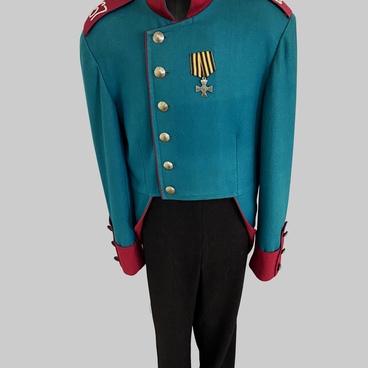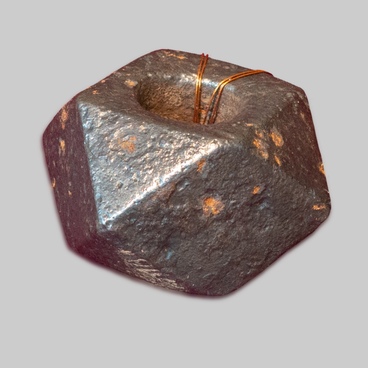Kuznetsk fortress is a fortification built by ‘exiled convicts’. The construction was managed by the officers of the engineering team. Principal working tools were spades and grafting-tools often made of wood and covered by an iron rim.
Apart from the weapons, regular and irregular troops of the Russian army in XVIII century also were equipped with certain tools. For example, out of one hundred rank and file soldiers and sergeants (‘uryadnicks’) in a dragoon company, eighty had an axe, ten had an iron spade, and another ten – a pick axe. Field fortification entrenchment tools available in the museum collection were required for the construction of fortification points and military camps. Most of fortifications were made of earth – a system of mounds and ditches. Construction and modernization of fortresses, redoubts, outposts at Siberian fortified lines required regular earthworks.
Before XIX century, the spades in Russia were wooden and differed in shape and size. Among several dozens of the wooden spades found in the excavations of Veliky Novgorod the researchers identified digging, grain, baking and snow spades. The last three types of spades were entirely made of wood, and the digging spades were additionally reinforced with iron nosing. Metal strips bent to follow the shape of a wooden spade were flattened to be 1-2 mm thick and welded in the outer edge. After that, the cutting edge of the nosing was hammered and sharpened with an emery disc. The nosing was usually attached to the wooden blade of the spade with rivets. The museum collection contains an iron nosing of the wooden spade edge found in Tyumen region and dated the earlier half of XVIII century.
The tool name in Russian (‘shantsevy’) derives from the German schanze translated as ‘trench, fortification’. It is a set of hand tools for the engineering works of military troops. In the Russian Emperor’s Army, it was part of military equipment – it was used to fortify the field positions.
There existed two types of field fortification entrenching tool sets: carriable and transportable. The first one was caried by people, so it was always available in each military unit. The transportable tool set was transported in military or engineering supply trains, and it could be non-available in the troops at certain moments of time.
The carriable set of field fortification entrenching tools was mainly used for digging trenches, overcoming obstacles and in hand-to-hand combats. Prior to the Great Patriotic War, apart from the entrenching shovel, the field fortification entrenching tool set also comprised a small axe and a small pick-mattock. The transportable field fortification entrenching tool set was used for the development of taken positions – location unit lines. It comprised a toothed knife, a large sapper shovel, a hand axe or a hacket, a pick-mattock, a two-handed saw, a crowbar and other tools depending on the planned engineering or construction works.
Apart from the weapons, regular and irregular troops of the Russian army in XVIII century also were equipped with certain tools. For example, out of one hundred rank and file soldiers and sergeants (‘uryadnicks’) in a dragoon company, eighty had an axe, ten had an iron spade, and another ten – a pick axe. Field fortification entrenchment tools available in the museum collection were required for the construction of fortification points and military camps. Most of fortifications were made of earth – a system of mounds and ditches. Construction and modernization of fortresses, redoubts, outposts at Siberian fortified lines required regular earthworks.
Before XIX century, the spades in Russia were wooden and differed in shape and size. Among several dozens of the wooden spades found in the excavations of Veliky Novgorod the researchers identified digging, grain, baking and snow spades. The last three types of spades were entirely made of wood, and the digging spades were additionally reinforced with iron nosing. Metal strips bent to follow the shape of a wooden spade were flattened to be 1-2 mm thick and welded in the outer edge. After that, the cutting edge of the nosing was hammered and sharpened with an emery disc. The nosing was usually attached to the wooden blade of the spade with rivets. The museum collection contains an iron nosing of the wooden spade edge found in Tyumen region and dated the earlier half of XVIII century.
The tool name in Russian (‘shantsevy’) derives from the German schanze translated as ‘trench, fortification’. It is a set of hand tools for the engineering works of military troops. In the Russian Emperor’s Army, it was part of military equipment – it was used to fortify the field positions.
There existed two types of field fortification entrenching tool sets: carriable and transportable. The first one was caried by people, so it was always available in each military unit. The transportable tool set was transported in military or engineering supply trains, and it could be non-available in the troops at certain moments of time.
The carriable set of field fortification entrenching tools was mainly used for digging trenches, overcoming obstacles and in hand-to-hand combats. Prior to the Great Patriotic War, apart from the entrenching shovel, the field fortification entrenching tool set also comprised a small axe and a small pick-mattock. The transportable field fortification entrenching tool set was used for the development of taken positions – location unit lines. It comprised a toothed knife, a large sapper shovel, a hand axe or a hacket, a pick-mattock, a two-handed saw, a crowbar and other tools depending on the planned engineering or construction works.



